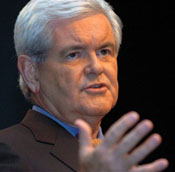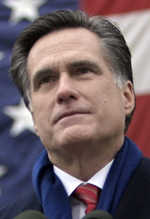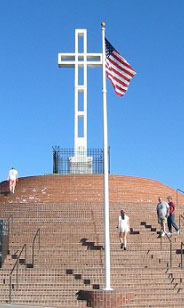Religion and politics 2012
Presidential candidates rev up the culture wars
By Bruce T. Murray
Author, Religious Liberty in America: The First Amendment in Historical and Contemporary Perspective

“I believe in an America where the separation of church and state is absolute …”
– John F. Kennedy, Sept. 12, 1960, speaking to the Greater Houston Ministerial Association
“I don’t believe in an America where the separation of church and state is absolute.”
– Rick Santorum, Feb. 26, 2012, speaking on ABC’s “This Week”
“In recent years, the notion of the separation of church and state has been taken by some well beyond its original meaning.”
– Mitt Romney, Dec. 6, 2007, speaking at the George H.W. Bush Presidential Library
Rhetoric from the 2012 presidential campaign
Political rhetoric regarding the separation of church and state has changed substantially since John F. Kennedy delivered his landmark speech on the issue in 1960. Cultural perspectives have also shifted dramatically: While Kennedy was trying to assuage the concerns of Protestants about the prospect of having a Catholic in the White House, the Catholic-Protestant issue has since become a non-issue. When Rick Santorum, a Catholic, assails secularism in society, he preaches to a chorus of both Catholics and Protestants.
The “culture wars” have driven a wedge between religious and secular-minded Americans, while at the same time unifying old foes – Catholics and Protestants. Common causes of concern include the removal of religious symbols from the public square, the treatment of religion in public schools and religious invocations at public events. When cultural-religious issues fire up voters, politicians respond accordingly by firing up the rhetoric. Santorum has been notably over-the-top in his statements on the subject.
“To say that people of faith have no role in the public square? That makes me throw up,” Santorum said on ABC’s “This Week.”
 Waning presidential candidate Newt Gingrich has chimed in the word-throwing with the zeal of a new convert. Gingrich decries what he characterizes as the “aggressive secularization” of America, modeled after trends in Europe. “The American elites are guided by their desire to emulate the European elites and, as a result, anti-religious values and principles are coming to dominate the academic, news media, and judicial class in America,” Gingrich said at the National Catholic Prayer Breakfast in 2011.
Waning presidential candidate Newt Gingrich has chimed in the word-throwing with the zeal of a new convert. Gingrich decries what he characterizes as the “aggressive secularization” of America, modeled after trends in Europe. “The American elites are guided by their desire to emulate the European elites and, as a result, anti-religious values and principles are coming to dominate the academic, news media, and judicial class in America,” Gingrich said at the National Catholic Prayer Breakfast in 2011.
Republican presidential candidate Mitt Romney has attempted to take a moderate position – criticizing what he calls “the religion of secularism,” while at the same time pointing out the importance of separation of church and state.
 “We separate church and state affairs in this country, and for good reason,” Romney said at his 2007 address at the George H.W. Bush Presidential Library. “No religion should dictate to the state nor should the state interfere with the free practice of religion. But in recent years, the notion of the separation of church and state has been taken by some well beyond its original meaning. They seek to remove from the public domain any acknowledgment of God. Religion is seen as merely a private affair with no place in public life. It is as if they are intent on establishing a new religion in America – the religion of secularism. They are wrong.”
“We separate church and state affairs in this country, and for good reason,” Romney said at his 2007 address at the George H.W. Bush Presidential Library. “No religion should dictate to the state nor should the state interfere with the free practice of religion. But in recent years, the notion of the separation of church and state has been taken by some well beyond its original meaning. They seek to remove from the public domain any acknowledgment of God. Religion is seen as merely a private affair with no place in public life. It is as if they are intent on establishing a new religion in America – the religion of secularism. They are wrong.”
The context of Romney’s 2007 address parallels Kennedy’s 1960 speech: As Kennedy was trying to allay fears about his Catholicism, Romney was trying to do the same regarding his Mormonism. And as Kennedy declared that “no Catholic prelate would tell the president – should he be Catholic – how to act,” Romney similarly stated that “no authorities of my church, or of any other church for that matter, will ever exert influence on presidential decisions.”
Unfortunately for Romney, he has not managed to shake off suspicions regarding either his church or his candidacy.
(See more on religion and the 2012 election here.)
‘No establishment’ in 1960
When Kennedy delivered his landmark speech to the Greater Houston Ministerial Association, the contours of church-state separation had already been substantially defined – although not “absolutely” so. In the landmark 1947 case, Everson v. Board of Education of the Township of Ewing, the Supreme Court “incorporated” the First Amendment’s Establishment Clause, which meant that the High Court would take an increasing role in determining church-state issues, rather than leaving the issue up to state and local governments to decide.
The Everson case involved a New Jersey state law that authorized local school districts to cover the transportation costs of sending children to Catholic schools. A taxpayer challenged the law, contending that it was unconstitutional to use public funds to pay for the costs of transporting children to sectarian schools. The Supreme Court held that the program was constitutional, because the primary purpose of sending the children to Catholic schools was for education and not religious indoctrination. Nonetheless, the Court made it clear that its standards were strict:
 “In the words of Jefferson, the clause against establishment of religion by law was intended to erect ‘a wall of separation between Church and State,’” Justice Hugo Black wrote for the Court.
“In the words of Jefferson, the clause against establishment of religion by law was intended to erect ‘a wall of separation between Church and State,’” Justice Hugo Black wrote for the Court.
More important than the particular issue in Everson, by incorporating the Establishment Clause, the Supreme Court made itself the final arbiter of church-state questions, rather than state legislatures, state courts or school boards. In the year following Everson, the Supreme Court struck down an Illinois program that allowed outside religious teachers to provide religious instruction in public schools for grades four through nine. The program was set up, theoretically, to allow Protestant, Catholic and Jewish teachers provide the religious instruction; and students who did not wish to participate could be excused. Nevertheless, the Court rejected the Champaign school district’s “entanglement” with religion and ruled the program unconstitutional. (McCollum v. Board of Education.)
‘No establishment’ after 1960
The Supreme Court severed many more church-state entanglements in the 1960s and beyond. In 1962, the Court struck down a mandatory school prayer in New York public schools (Engel v. Vitale); and in 1963, the Court ruled that public schools in Pennsylvania may not lead prayers or Bible recitations, even if students are freely excused from participating. (School District of Abington Township v. Schempp.)
In the 1980s, the Court set its sights on religious symbols in public places, adding new fuel to the culture wars. In 1984, a divided Court upheld the constitutionality of a nativity scene in Rhode Island (Lynch v. Donnelly); but in 1989, an even further sub-divided Court struck down a nativity display in a Pennsylvania courthouse, while simultaneously giving its OK to a menorah and Christmas tree display next to the municipal administration building in Pittsburgh. (Allegheny County v. ACLU.) The Court has also handed down conflicting decisions regarding public displays of the Ten Commandments.

More recently, the Court has held back on striking down public religious displays. In 2009, the Court declined to rule against a cross in the Mojave Desert (Salazar v. Buono); and the Court is likely to take up the case of the cross atop Mt. Soledad in San Diego.
With the Supreme Court so heavily involved in First Amendment religious establishment cases, many on the conservative side of the issue are prone to blaming the Court for the secularization of American society.
“The courts have been especially powerful engines of coerced secularization. From the 1962 school prayer decision on, there has been a decisive break with the essentially religious nature of historic American civilization,” Newt Gingrich said.
“Our greatness would not long endure without judges who respect the foundation of faith upon which our constitution rests,” Mitt Romney said. “We should acknowledge the Creator as did the Founders – in ceremony and word. He should remain on our currency, in our pledge, in the teaching of our history, and during the holiday season, nativity scenes and menorahs should be welcome in our public places.”
Despite the Supreme Court’s substantial involvement in religious liberty issues, the ongoing process of detachment of church and state has been taking place for much longer – and outside the Court’s involvement. The history of church and state in America is surveyed in the University of Massachusetts Press book, Religious Liberty in America: The First Amendment in Historical and Contemporary Perspective by Bruce T. Murray. See more information on the book here.

